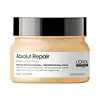What's inside
What's inside
 Key Ingredients
Key Ingredients

No key ingredients
 Benefits
Benefits

 Concerns
Concerns

 Ingredients Side-by-side
Ingredients Side-by-side

Water
Skin ConditioningStearyl Alcohol
EmollientBehentrimonium Chloride
PreservativeCetyl Alcohol
EmollientParfum
MaskingPanthenol
Skin ConditioningIsopropyl Alcohol
SolventBenzyl Alcohol
PerfumingPhenoxyethanol
PreservativePEG-2m
Emulsion StabilisingMethylparaben
PreservativePropylene Glycol
HumectantQuaternium-80
Propylparaben
PreservativeDisodium EDTA
Hexyl Cinnamal
PerfumingCoumarin
PerfumingCitronellol
PerfumingSilica
AbrasiveCitric Acid
BufferingArgania Spinosa Kernel Oil
EmollientSimmondsia Chinensis Seed Oil
EmollientBHT
AntioxidantWater, Stearyl Alcohol, Behentrimonium Chloride, Cetyl Alcohol, Parfum, Panthenol, Isopropyl Alcohol, Benzyl Alcohol, Phenoxyethanol, PEG-2m, Methylparaben, Propylene Glycol, Quaternium-80, Propylparaben, Disodium EDTA, Hexyl Cinnamal, Coumarin, Citronellol, Silica, Citric Acid, Argania Spinosa Kernel Oil, Simmondsia Chinensis Seed Oil, BHT
Water
Skin ConditioningCetearyl Alcohol
EmollientBehentrimonium Chloride
PreservativeCandelilla Cera
EmollientAmodimethicone
Cetyl Esters
EmollientIsopropyl Alcohol
SolventGlycerin
HumectantPhenoxyethanol
PreservativeTrideceth-6
EmulsifyingLinalool
PerfumingLactic Acid
BufferingHexyl Cinnamal
PerfumingChlorhexidine Digluconate
AntimicrobialCetrimonium Chloride
AntimicrobialLimonene
PerfumingSodium Hydroxide
BufferingChenopodium Quinoa Seed Extract
Skin ConditioningHydroxypropyltrimonium Hydrolyzed Wheat Protein
Skin ConditioningCI 19140
Cosmetic ColorantCI 15985
Cosmetic ColorantParfum
MaskingWater, Cetearyl Alcohol, Behentrimonium Chloride, Candelilla Cera, Amodimethicone, Cetyl Esters, Isopropyl Alcohol, Glycerin, Phenoxyethanol, Trideceth-6, Linalool, Lactic Acid, Hexyl Cinnamal, Chlorhexidine Digluconate, Cetrimonium Chloride, Limonene, Sodium Hydroxide, Chenopodium Quinoa Seed Extract, Hydroxypropyltrimonium Hydrolyzed Wheat Protein, CI 19140, CI 15985, Parfum
 Reviews
Reviews

Ingredients Explained
These ingredients are found in both products.
Ingredients higher up in an ingredient list are typically present in a larger amount.
This ingredient is a preservative and often used for it's anti-static properties. You'll most likely see this ingredient in hair conditioners.
It does not cause irritation or sensitization in leave-on products at 1-5%.
Hexyl Cinnamal is a fragrance ingredient with a similar scent to jasmine. It can be naturally found in chamomile essential oil.
This ingredient is a known EU allergen and may sensitize the skin. The EU requires this ingredient to be listed separately on an ingredients list.
Hexyl Cinnamal is not water soluble but is soluble in oils.
Learn more about Hexyl CinnamalIsopropyl Alcohol is more commonly known as rubbing alcohol. It is most commonly used as a solvent, meaning it helps other ingredients dissolve.
This ingredient is an astringent alcohol. Astringent alcohols may also irritate skin as they high amounts may strip away your skin's natural oils.
Other types of astringent alcohols include:
According to the National Rosacea Society based in the US, you should be mindful of products with these alcohols in the top half of ingredients.
Any type of sanitizing product will have high amounts of alcohol to help kill bacteria and viruses.
Learn more about Isopropyl AlcoholParfum is a catch-all term for an ingredient or more that is used to give a scent to products.
Also called "fragrance", this ingredient can be a blend of hundreds of chemicals or plant oils. This means every product with "fragrance" or "parfum" in the ingredients list is a different mixture.
For instance, Habanolide is a proprietary trade name for a specific aroma chemical. When used as a fragrance ingredient in cosmetics, most aroma chemicals fall under the broad labeling category of “FRAGRANCE” or “PARFUM” according to EU and US regulations.
The term 'parfum' or 'fragrance' is not regulated in many countries. In many cases, it is up to the brand to define this term.
For instance, many brands choose to label themselves as "fragrance-free" because they are not using synthetic fragrances. However, their products may still contain ingredients such as essential oils that are considered a fragrance by INCI standards.
One example is Calendula flower extract. Calendula is an essential oil that still imparts a scent or 'fragrance'.
Depending on the blend, the ingredients in the mixture can cause allergies and sensitivities on the skin. Some ingredients that are known EU allergens include linalool and citronellol.
Parfum can also be used to mask or cover an unpleasant scent.
The bottom line is: not all fragrances/parfum/ingredients are created equally. If you are worried about fragrances, we recommend taking a closer look at an ingredient. And of course, we always recommend speaking with a professional.
Learn more about ParfumPhenoxyethanol is a preservative that has germicide, antimicrobial, and aromatic properties. Studies show that phenoxyethanol can prevent microbial growth. By itself, it has a scent that is similar to that of a rose.
It's often used in formulations along with Caprylyl Glycol to preserve the shelf life of products.
Water. It's the most common cosmetic ingredient of all. You'll usually see it at the top of ingredient lists, meaning that it makes up the largest part of the product.
So why is it so popular? Water most often acts as a solvent - this means that it helps dissolve other ingredients into the formulation.
You'll also recognize water as that liquid we all need to stay alive. If you see this, drink a glass of water. Stay hydrated!
Learn more about Water